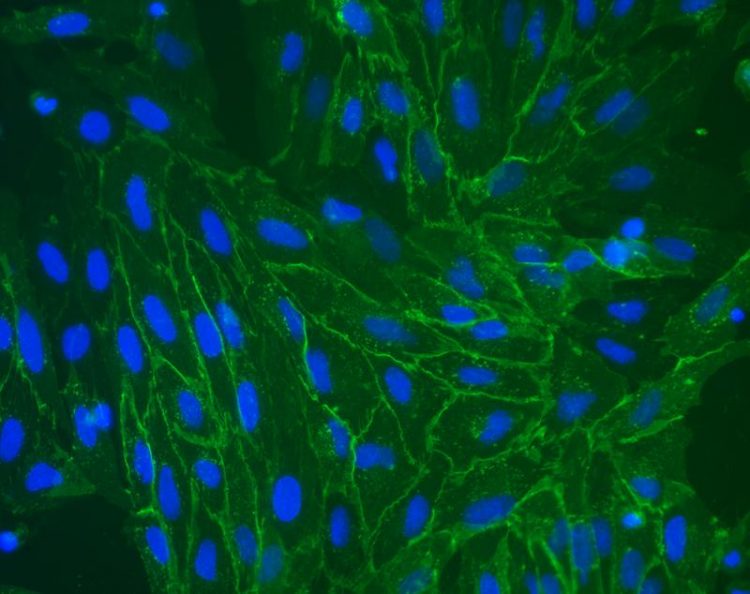New Diagnostic Tool Aids Quality Control in Xenotransplantations

Flourescein—tagged Lectins a new probe for detecting sugars in pig cells. © Beshir et al. 2017
Sugars are highly important molecules for all life. They convey vital signals, and thus participate in manifold biological processes (e.g. determination of blood-types and the formation of bacterial biofilms). Sugars are often recognized by specialized proteins called lectins.
Researchers at the Helmholtz Institute for Pharmaceutical Research Saarland (HIPS), a branch of the Helmholtz Centre for Infection Research (HZI), recently identified a novel lectin in the bacterium Photorhabdus luminescens. This lectin is highly selective for so-called “α-gal” sugars, which are produced on the cells of pigs and New World monkeys.
Pig cells are often used for tissue grafts from pigs to humans, in which the transplanted pig cells need to be modified by genetic engineering in order to prevent a vigorous immune response to the α-gal (also called xenoantigen) normally found on pig cells. The newly discovered lectin may be used as a diagnostic tool and for quality control in the future. The researchers published their results in the Journal of Biological Chemistry.
Sugar-binding proteins called lectins are widespread in all domains of life and used as virulence factors in numerous bacteria, e.g. in Pseudomonas aeruginosa. Lectins make it easier for the microorganisms to adhere to the host for the purpose of infection.
This motivated Dr Alexander Titz, who is the head of the “Chemical Biology of Carbohydrates” junior research group of the Helmholtz Centre for Infection Research (HZI) and of the German Center for Infection Research (DZIF)who is the head of the “Chemical Biology of Carbohydrates” young researcher group at the HIPS, to compare lectins from different bacteria: “We wanted to find out if there are additional lectins in other types of bacteria that show high specificity forcertain sugars.” His research group scoured sequence databases in the search for new lectins and found one in the bacterium Photorhabdus luminescens that piqued their interest.
Photorhabdus bacteria lead a symbiotic life in nematodes and infest larger organisms. “The Photorhabdus lectin surprisingly showed a very high specificity for the sugar structure α-gal that occurs in pigs and New World monkeys,” says Alexander Titz. “After this discovery, we wanted to know exactly how this works.”
Light was shed on this question through a collaboration with Dr Jesko Köhnke, who is the head of the “Structural Biology of Biosynthetic Enzymes” young investigator group at the HIPS. “We elucidated the crystal structure of the new lectin – bound to different sugars – in order to understand the binding properties of the molecule,” says Köhnke.
The findings of the two research groups, which was driven by blue-sky research, has now serendipitously led to a clinical application as a diagnostic tool. The special sugar α-gal recognised by the Photorhabdus lectin plays an important role in organ transplantations of foreign tissues into humans.
Due to the lack of human organ donors, it is quite common to transplant tissues from pigs, for example heart valves. Pig cells usually have α-gal on their surface. This is recognised by the human immune system and leads to vigorous defence reactions of the human body in the form of acute organ/cell rejection. Modern genetic engineering methods have been used to produce pig cells that are void of α-gal on their surface. But the success of these methods must be closely monitored:
The Photorhabdus lectin may be used for quality control in this context in order to make sure that no α-gal is present. Until now, a lectin from seeds of an African plant called Griffonia simplicifolia was used for this purpose, the isolation of which is a complicated process. In contrast, the newly described lectin is comparatively easy and inexpensive to produce and has been tested successfully for these purposes by the research group of Prof Eckhard Wolf at the Veterinary Faculty of the Ludwig-Maximilians-University in Munich.
The HIPS researchers also do not rule out a broader use of the diagnostic tool for α-galactosylated sugars. “The ABO blood group system of humans is also defined by sugars. Here, the Photorhabdus lectin might be used as a new typing system,” says Titz.
Original publication:
Ghamdan Beshr, Asfandyar Sikandar, Eva-Maria Jemiller, Nikolai Klymiuk, Dirk Hauck, Stefanie Wagner, Eckhard Wolf, Jesko Koehnke, Alexander Titz: Photorhabdus luminescens lectin A (PIIA) – a new probe for detecting α-galactoside-terminating glycoconjugates. Journal of Biological Chemistry, 2017, DOI: 10.1074/jbc.M117.812792
The Helmholtz Centre for Infection Research:
Scientists at the Helmholtz Centre for Infection Research (HZI) investigate the mechanisms of infections and of the defences against infections. What is it that makes bacteria or viruses pathogenic? The answer to this question is expected to be key to the development of new medications and vaccines.
http://www.jbc.org/content/early/2017/09/28/jbc.M117.812792 – publication
https://www.helmholtz-hzi.de/en/news_events/news/view/article/complete/new_diagn… – press release
http://www.helmholtz-hzi.de – Webpage HZI
Media Contact
All latest news from the category: Life Sciences and Chemistry
Articles and reports from the Life Sciences and chemistry area deal with applied and basic research into modern biology, chemistry and human medicine.
Valuable information can be found on a range of life sciences fields including bacteriology, biochemistry, bionics, bioinformatics, biophysics, biotechnology, genetics, geobotany, human biology, marine biology, microbiology, molecular biology, cellular biology, zoology, bioinorganic chemistry, microchemistry and environmental chemistry.
Newest articles

High-energy-density aqueous battery based on halogen multi-electron transfer
Traditional non-aqueous lithium-ion batteries have a high energy density, but their safety is compromised due to the flammable organic electrolytes they utilize. Aqueous batteries use water as the solvent for…

First-ever combined heart pump and pig kidney transplant
…gives new hope to patient with terminal illness. Surgeons at NYU Langone Health performed the first-ever combined mechanical heart pump and gene-edited pig kidney transplant surgery in a 54-year-old woman…

Biophysics: Testing how well biomarkers work
LMU researchers have developed a method to determine how reliably target proteins can be labeled using super-resolution fluorescence microscopy. Modern microscopy techniques make it possible to examine the inner workings…





















